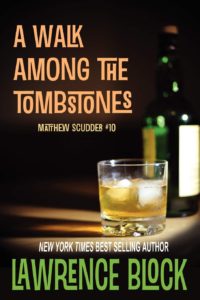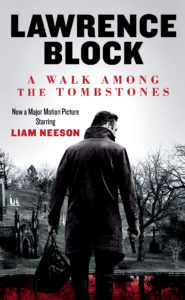Oh, there you are, LB. Still got a pulse, eh? Still capable of sitting up and taking nourishment?
Sarcasm is so easy, isn’t it? And perhaps justified, as I have in fact been silent for a month or two…
Or three.
…but I’ve been busy.
With things you won’t talk about.
 Not just yet, no. But something else inspires me to break my long silence. A few days ago, Netflix decided to Spring Forward by offering its subscribers A Walk Among the Tombstones, the 2014 film written and directed by Scott Frank and starring Liam Neeson. And I’m evidently not the only one to find this cause for rejoicing. In no time at all AWATT was the streaming service’s #10 title, and the last I heard it had moved up into second place.
Not just yet, no. But something else inspires me to break my long silence. A few days ago, Netflix decided to Spring Forward by offering its subscribers A Walk Among the Tombstones, the 2014 film written and directed by Scott Frank and starring Liam Neeson. And I’m evidently not the only one to find this cause for rejoicing. In no time at all AWATT was the streaming service’s #10 title, and the last I heard it had moved up into second place.
The film’s pulling in a whole lot of new eyeballs, as one might say, and it’s also generating a good deal of chatter, online and elsewhere. Seven years after its release, the movie’s drawing the enthusiastic reviews that it didn’t get back in the day.
I’m not surprised. What did surprise me, back in 2014, was how utterly A Walk Among the Tombstones failed to find its audience. I saw the film before its release, and I thought it was a clear winner. Liam Neeson had been at the top of my Scudder wish list ever since I saw him in Michael Collins, and his performance was pitch-perfect, his screen presence magnetic. Scott Frank’s script was taut and solid, and the cinematography (Mihai Malaimare Jr.) and the score (Carlos Rafael Rivera) were both impeccable. With all that going for it, why shouldn’t the movie get raves from the critics and sell a ton of tickets?
One word: Taken.
In 2008, the film with that title made Liam Neeson an action-adventure star, and was successful enough to launch two sequels imaginatively entitled, with the imagination and ingenuity for which the industry is justly renowned, Taken 2 and Taken 3. They were, as they say, excellent examples of what they were, and they put a lot of bottoms in a lot of seats.
 And they took all the air out of A Walk Among the Tombstones. Because, unlike the Taken films, it never set out to be a pulse-pounding action thriller. It was thoughtful and measured and character-driven, very much the sort of film adaptation a Matthew Scudder novel ought to inspire.
And they took all the air out of A Walk Among the Tombstones. Because, unlike the Taken films, it never set out to be a pulse-pounding action thriller. It was thoughtful and measured and character-driven, very much the sort of film adaptation a Matthew Scudder novel ought to inspire.
So the Taken fans found it lacking, and told their friends to give it a pass. And AWATT’s ideal audience never bought tickets in the first place, expecting another Taken installment under another name.
And the critics were no help.
Never mind. The picture’s finding its audience, and it’s the late-in-life hit it should have been seven years ago.
And you’re raking in the bucks, right?
Um, that’s not how it works. I got paid when they made the film, and I’d have earned some bonus money if it had been a major hit, but it wasn’t, and its new life on Netflix won’t put any money in my pockets. But, you know, that’s okay. I’m not walking around with empty pockets. And this way my motive for urging you to see the movie is not ulterior but altruistic.
So—if you’re a Netflix subscriber, and if you haven’t seen A Walk Among the Tombstones, I would urge you to do so. If you saw it some years ago, I’d advise you to see it again. There’s a lot to like about the picture, not least of all the way Liam Neeson contrives to embody the character of Matthew Scudder.
 And, whether or not you watch the movie, I’ll urge you to read the novel. I admire the film greatly, for all the reasons I’ve cited, but it’s not perfect. There are ways in which the book is superior.
And, whether or not you watch the movie, I’ll urge you to read the novel. I admire the film greatly, for all the reasons I’ve cited, but it’s not perfect. There are ways in which the book is superior.
For one, the story’s better. It’s easier, after all, for a novel to have a better storyline than its film adaptation. If a book’s rich in incident and texture, it’s going to lose something in translation. And, when the timespan between film option and theatrical release is fifteen years, the erosion can be considerable.
Elaine Mardell, Scudder’s girlfriend, plays a major role in the novel; she doesn’t exist in the film. A surviving victim of the killers provides a key lead; she’s omitted altogether. A dismally trite plot device—Scudder’s case butting up against some unrelated drug investigation—is pressed into service. TJ, while played well enough by the rapper Astro, has way more dimension in the book. And the film’s ending is at once hoked up and less powerful.
I can see you really loved it.
It’s a good movie. But it would have been a better one if the script had tracked closer to the book. I know Scott told me he regretted having lost Elaine; I think if he’d made AWATT later than he did, after Godless and The Queen’s Gambit, he might have made a few different choices, ones that to my mind would have served the film better.
Never mind. If you have access to Netflix, see the movie—sooner rather than later, as I don’t know how long they’ll be making it available. If you don’t have Netflix access, you can hunt for it elsewhere; it’s shown up from time to time on premium cable, and I’ve no idea where else you may be able to find it.
And read the book. It’s not hard to find.
Cheers,


Hello LB,
Glad to see you back! I just bought the book. I see it is #10 that means I will have to buy even more later. I still like Bernie and Keller best of your characters so far. As far as movies Liam Neeson and you will survive the fickle Hollywood crowd. The best movie I ever saw that featured crime was Foul Play with Goldie Hawn and Chevy Chase and a cast of Hollywood’s greatest. It was so funny I thought I would pass out laughing. I seem to remember that the movie’s release was cancelled and held up for quite a while as someone did actually shoot the Pope at that time. My favorite TV series was Granada TV’s Sherlock Holmes with Jeremey Brett.
I love this film. Lawrence Block is a writer who has had a huge influence on my reading all of his books, I even have the giant framed poster of AWATT. I was looking forward to seeing LB on the movie but his small but meaningful part was cut and I wasn’t happy about that but it’s a great movie and all the Matt Scudder books are brilliant. Please watch it or read the book.
Hello again LB,
I imagine you already know that I love books the best. Movies are OK but I agree with you books are better. I also love history and humor. I get a kick out of the humor with Bernie and the irony of a hit man who supports his stamp collecting hobby by removing certain distasteful people. I seem to remember in one of your stories Bernie lifted some stamps from a collection in an apartment that he was robbing- not Keller’s by any chance? That would be most ironic!
It was a great book, but my memory fails me to remember the movie, I will Have to see it, maybe again maybe not it is always a pleasure to revisit a good story if it’s told by a master.
I just can’t get myself to watch the movie. I loved the Book. I really loved the book. After seeing how Bernie was turned into Whoopie Goldberg makes me really not want to see The Movie. I had little interest in Taken much less 2 or 3 just for the fact of how can anyone trust someone who keeps losing his people? I can only watch movies where I haven’t read the book yet, I wait until after then I can find out what was really going on.
A lot of the more adult-oriented movies flop in theaters because most successful theater movies these days are the ones aimed at teens and under, aka Marvel and Star Wars and such. Just ask Ridley Scott about that. I don’t have Netflix but I own the movie on Blu-Ray with a digital copy on Amazon and I have the book on Kindle. Cha-ching.
Elaine would have added a great deal to AWATT – she adds a great deal to each novel she appears in IMHO. Movie is well done but there needs to be another movie or 2 made. Keller too for that matter ….Had a moment a few weeks ago, I was trolling through my collection of Scudder novels, wondering which one I should read ….again….. came across a bit of conversation between Matt and Jim Faber, can’t quote it exactly but ….. I strangled my grandmother this morning …… she probably had it coming ….. important thing is you didn’t drink ….. Got another good chuckle out of that ….. as I had years ago when I first read it. Thanks again for Scudder, for Keller …. all the novels and short stories. JeffM
Thumbs up! I haven’t gotten around to reading Scudder yet. Bit I have been in desperate need of an LB fix!
So I came at this in exactly the way you described (not that Taken prevented me from seeing AWATT) rather I saw the movie offered on cable, recorded it, watched it and loved the movie so much that I am now reading all the Scudder books in order…although I am having trouble locating a copy of “In the Midst of Death” as I prefer hardcover books. I’m on the prowl, however, and maybe I’ll get lucky. I’ve read all, or most of, the Bernie Rhodebarr series and all or most of The Keller novels. I’m sorry it’s taken me so long to “discover” Scudder but better late than never, right? I appreciate the fact that AWATT isn’t an action packed, pulse pounding blur (although there isn’t anything wrong with that. I actually liked the first “Taken” very much) but I appreciate the “slow burn” that is AWATT and was looking online just last night at Mr Block’s IMDB page in hopes of news for more Scudder (with Neeson) movies.
Being a Lawrence Block fan AND a Liam Neeson fan, I found both AWATTs enjoyable. Having seen all four movies (AWATT and TAKENS) back in the day, I didn’t understand why the movie wasn’t more popular. And I think I’ll revisit AWATT on Netflix.
Good to hear from you, LB!
I saw the film when it was released. I enjoyed it and Neeson did a fine job as Scudder. I also bought the DVD when it came out. Considering what H’wood has done to your novels, I was also greatly relieved: No one was relo’ed to another coast and the actor selected worked quite well as Scudder. Looking forward to whatever you’re working on now, and best wishes.
Hi LB,
Your Scudder novels are my favorites. I enjoyed the movie and couldn’t believe it wasn’t a huge hit. Today I searched Hulu with no luck finding the movie. It can be rented on Amazon Prime for $3.99. I’m glad it is finally getting an audience.
Welcome Back and good to read from you!
Remarkable timing, Mr. B—I began watching this last night. It’s terrific from the start, but I got interrupted by Life Itself. Can’t wait to finish it. Liam is perfect for Scudder, I agree. Congratulations on finding a new audience for your work, which I’ve so admired as a reader and crime writer for, well, ever.
I just finished the movie, “Walk Amount the Tombstones” on Netflix last night. The rescue of the little girl in the cemetary was scary. The ending cringeworthy yet satisfying. My shoulders were up to my ears, brow furrowed and mouth agape until it ended.